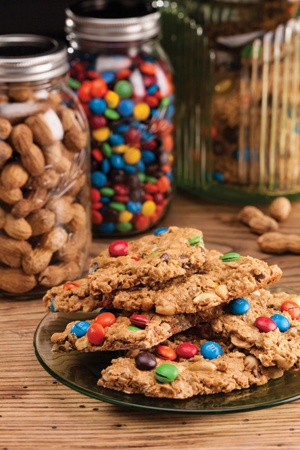It’s hard to find a food more versatile than the peanut, and Texas has long been one of the country’s leading producers. The mighty legume, a good source of monounsaturated fat, fiber and protein, remains a stalwart of Texas agriculture. Our state holds the distinction of growing all four types of peanuts including runners, Spanish, Virginia and Valencia. Each is usually identified with certain foods. For instance, runners are commonly used in peanut butter, while the high-oil, papery-skinned Spanish peanuts are often used in candy.
Through history, peanuts have been grown in various Texas towns, including Aubrey, Whitesboro and Floresville. These towns no longer consider peanuts a cash crop but still each honor their peanut-growing heritage at festivals held every October. These days, the “peanut capital” of Texas is Gaines County, the largest peanut-producing county in the state—and the entire country, according to the Texas Peanut Producers Board. Nearby Terry County also grows peanuts and is home to shelling facilities including Birdsong and Golden Peanut, which supply nuts to some of the country’s most recognizable brands.
Here’s one of my favorite peanut recipes, Monster Bark, a free-form cookie cut into pieces and served like candy bark or brittle.
Monster Bark
1 large egg
1/3 cup granulated sugar
1/3 cup packed light brown sugar
3/4 teaspoon baking soda
3/8 scant teaspoon kosher salt
1/2 teaspoon vanilla extract
1/2 cup peanut butter (4.8 ounces on a scale)
3 tablespoons unsalted butter, melted
2 1/2 tablespoons all-purpose flour
1 1/2 cups quick-cooking or old-fashioned (not instant) oats
1/4 cup semisweet chocolate or peanut butter chips
1/4 cup mini candy-coated chocolates (M&M’s)
1/3 cup chopped, lightly salted peanuts
- Preheat oven to 250 degrees. Line a large (about 18-by-13-inch), rimmed, heavy-duty baking sheet with parchment paper.
- In a mixing bowl, stir together the egg, both types of sugar, baking soda, salt and vanilla. Stir in the peanut butter and butter. When mixed, add flour and stir until blended. Lastly, stir in the oats, chips, candies and peanuts.
- Empty onto the baking sheet and divide dough into two sections.
- Dampen fingers and press each section down to make it as thin as possible. You could make one big slab, but making two gives you more edge pieces and more crunch.
- Bake for 45 minutes. Remove from the oven and slide parchment onto a cutting board. With a pizza cutter, cut the slabs into multiple uneven pieces—but do not separate cut pieces, as the cookies will still be rather crumbly at this point. Return parchment paper with cookies to baking sheet.
- Return to the oven and bake for another 15 to 20 minutes. Let cool for about 10 minutes on baking sheet and carefully transfer to a wire rack to cool completely. Cookies should crisp as they cool.
Servings: 12. Serving size: 2 cookies. Per serving: 229 calories, 6.1 g protein, 12.9 g fat, 25.6 g carbohydrates, 2.2 g dietary fiber, 240 mg sodium, 15.4 g sugars, 23 mg cholesterol
Cook’s Tip: If you have some thicker pieces that aren’t crunchy once cooled, throw them back in the 250-degree oven for another 10 to 15 minutes, then let cool. The thinner you press the slabs, the better chance you have of getting crunchy bark.


